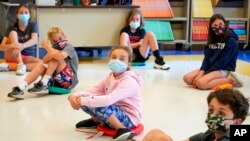Four years after the COVID-19 pandemic closed schools and upended child care, the Centers for Disease Control and Prevention says parents can begin treating the virus like other respiratory illnesses.
Gone are the mandatory quarantine periods and masking measures. But will schools and childcare centers agree?
In case you forgot: By Friday, all Americans, including schoolchildren, should stay home if they have COVID-19 for at least five days and then wear a mask for the prescribed period of control and prevention, according to the Centers for Disease Control and Prevention. .
Now, as COVID-19 deaths and hospitalizations decline, the CDC says children can return to school when their overall symptoms improve and they are fever-free for 24 hours without medication. Students are “encouraged” to wear masks when they return.
Still, the change likely won’t affect the way individual schools urge parents to respond when their children get sick. Schools and child care providers have a mixed record of following CDC recommendations and often turn to local authorities for final decisions. Sometimes other goals, such as reducing absenteeism, may influence state or district decisions.
The result could be a confusing array of policies across states and territories, not to mention workplaces — confusing parents whose lives have already been upended by the virus.
“It’s so confusing,” said Gloria Cunningham, a single mother in the Boston area. “I just don’t know what to think about COVID-19 right now. Is it still a monster?”
Cunningham, who manages a local store for a national restaurant chain, said her company would have asked her to take 10 days off if she contracted COVID-19. The school system where her son is in second grade is still sending coronavirus test kits to children for use before returning to school after a long break.
“I feel like we should either repeal any measures that treat COVID-19 differently or keep all the precautions in place,” she said.
Public education systems have long adopted varying policies on COVID-19. For the 2021-22 school year, only 18 states are following CDC recommendations for wearing masks in classrooms. When the Centers for Disease Control and Prevention (CDC) lifted mask guidance in February 2022, states such as Massachusetts followed suit, but California retained a mask requirement in schools.
In child care, some providers have long used stricter testing and isolation protocols than those recommended by the CDC. The reasons range from trying to prevent outbreaks to keeping employees healthy — both for their personal safety and to keep daycare centers open.
Some states adopted looser guidelines ahead of the CDC. California and Oregon recently lifted COVID-19 quarantine requirements, and many areas followed their recommendations.
To minimize absenteeism and address chronic absenteeism, California is encouraging children to attend school if their illness is mild and says students who test positive for the coronavirus but are asymptomatic can attend school. School systems in Los Angeles and San Diego, among others, have adopted the policy.
But most large urban areas across the country are still requiring parents to quarantine their children for at least five days before returning to school. Some schools, including Boston and Atlanta, are requiring students to wear masks for an additional five days and report positive COVID-19 tests to school.
Some school leaders say the CDC’s previous five-day quarantine requirement has been loosely followed.
The official policy in Burlington, Mass., is that if a student tests positive, they must stay home for five days. But Sheriff Eric Conte said the real policy is actually: “This is a virus. Deal with it.”
That’s because COVID-19 is being managed at home using the honor system.
“No one can enforce the five-day COVID policy without school-based testing,” he said via text message.
The Reedley School District in suburban Philadelphia is already using policies similar to the new CDC guidelines, Superintendent Lee Ann Wentzel said. Students who test positive for the coronavirus must be fever-free without medication for at least 24 hours before they can return to school. When they come back, they have to wear masks for five days. Wenzel said the district is now considering waiving the mask requirement because of new guidance from the CDC.
Specific guidelines for schools or day care centers are important for working parents who must be absent from school if their children cannot attend school or day care. In October 2023, amid simultaneous surges in COVID-19, respiratory syncytial virus and influenza, 104,000 adults reported losing their jobs due to child care issues, the highest number in at least a decade. The numbers have dropped: Last month, child care issues put 41,000 adults out of work, according to the Bureau of Labor Statistics.
Melissa Colagrosso’s child care center in West Virginia dropped special coronavirus guidelines about a year ago, she said. Now, they are treated like other illnesses: the child must have been free of serious symptoms, such as fever, for at least 24 hours before returning to the center.
“We’re certainly treating COVID-19 the same way we treat the flu or hand, foot and mouth disease,” said Cora Grosso, CEO of A Place To Grow Children’s Center in Oak Hill.
What about children who are asymptomatic but test positive for COVID-19? Colagrasso said most parents stop testing their children unless they develop symptoms, so she hasn’t faced this dilemma.
Still, some parents worry the relaxed rules will put their communities at greater risk. Evelyn Alemán leads a group of Latino and Indigenous immigrant parents in Los Angeles County. The parents she represents, many of whom have chronic illnesses and lack access to health care, were panicked when California lifted its quarantine requirement in January.
“I don’t think they’re thinking about the impact this will have on our families,” she said of California officials. “It feels like they don’t care — that we’re almost expendable.”
Even when restrictions are lifted, other impacts of the pandemic remain. Superintendent Wenzel said that in Reedley, the Philadelphia area, more students are more reclusive and find it difficult to interact face-to-face with their peers. Interest in school dances plummeted.
“Emotionally,” Wenzel said, “they were in trouble.”
Follow us on Google news ,Twitter , and Join Whatsapp Group of thelocalreport.in


















